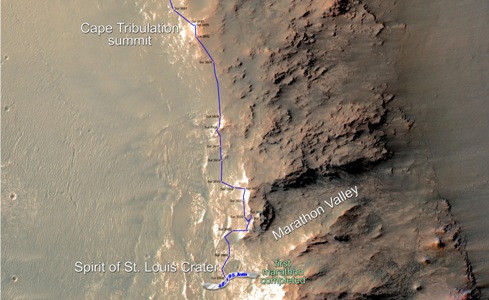
This map shows the southward path driven by Opportunity from late December 2014 until it passed marathon distance on March 24, 2015, during the 3,968th Martian day, or sol, of the rover's work on Mars. Photo: NASA/JPL-Caltech/Univ. of Arizona
WASHINGTON (PTI): NASA's Mars rover Opportunity has completed its first Red Planet marathon, clocking 42.195 kilometres in a finish time of roughly 11 years and two months.
Opportunity, whose mission is to search for signs of ancient water on Mars, completed the marathon on March 24, NASA said.
"This mission isn't about setting distance records; it's about making scientific discoveries," said Steve Squyres, Opportunity principal investigator at Cornell University.
"Still, running a marathon on Mars feels pretty cool," said Squyres.
Today the Red Planet has a breathtakingly thin atmosphere, with conditions deadly to almost every known form of life on Earth, NASA said.
Billions of years ago, however, things might have been different. Many researchers believe that Mars was once warmer, wetter, and friendlier to potential Martian life. The rover's job is to search for clues to that ancient time.
On a typical drive day, the rover travels only 50 to 100 meters. This gives the rover time to safely traverse the rocky terrain, pause and look for the unknown.
The long-lived rover surpassed the marathon mark during a drive of only 46.9 meters or 154 feet.
"When Opportunity landed on Mars 11 years ago, no one imagined this vehicle surviving a Martian winter, let alone completing a marathon," said Mars Exploration Rover Project Manager John Callas of Jet Propulsion Laboratory (JPL).
"This particular marathoner had to fly about 283 million miles across space before being unceremoniously drop-bounced on the Martian surface in 2004," said Ray Arvidson, a member of the Opportunity science team from Washington University.
Opportunity first uncovered signs of water in deposits near the landing site in Eagle Crater. There were rocks that seemed to have formed in an ancient shallow lake, albeit too acidic for life, the US space agency said.
Next, mission planners set their sights on Endeavour Crater - an enormous pit 14 miles wide and hundreds of meters deep.
Endeavour's depth would offer a look farther back into the history of Mars, to a time when the water was possibly less acidic.
"Raging dust storms reduced the rover's solar power so much that Opportunity almost entered the "sleep of death"; soft, sandy, wind-blown ripples trapped the rover's wheels, and there was an injury: a failure in Opportunity's right front steering actuator, which made running forward tricky," NASA said.
 Previous Article
Previous Article Next Article
Next Article












The Indian Air Force, in its flight trials evaluation report submitted before the Defence Ministry l..
view articleAn insight into the Medium Multi-Role Combat Aircraft competition...
view articleSky enthusiasts can now spot the International Space Station (ISS) commanded by Indian-American astr..
view article